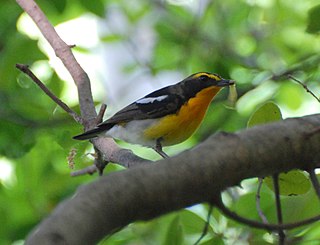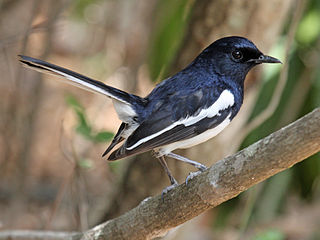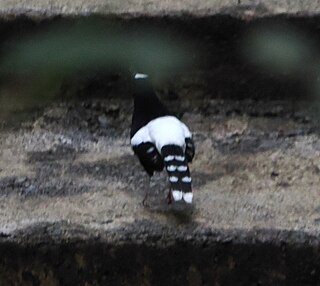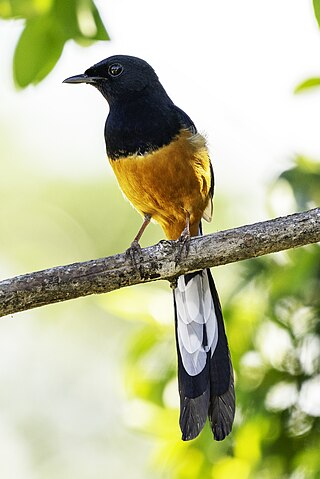
The white-rumped shama is a passerine bird in the Old World flycatcher family Muscicapidae. Native to densely vegetated habitats in the Indian subcontinent and Southeast Asia, its popularity as a cage-bird and songster has led to it being introduced elsewhere. The Larwo shama, the Kangean shama and the Sri Lanka shama were formerly considered to be conspecific with the white-rumped shama.

The narcissus flycatcher is a passerine bird in the Old World flycatcher family. It is native to the East Palearctic, from Sakhalin to the north, through Japan across through Korea, mainland China, and Taiwan, wintering in southeast Asia, including the Philippines, Vietnam and Borneo. It is highly migratory, and has been found as a vagrant from Australia in the south to Alaska in the north.

The edible-nest swiftlet, also known as the white-nest swiftlet, is a small bird of the swift family which is found in Southeast Asia. Its opaque and whitish bird nest is made exclusively of solidified saliva and is the main ingredient of bird's nest soup, a delicacy of Chinese cuisine. Germain's swiftlet is now treated as conspecific with this species.

The Madagascar magpie-robin is a species of chat in the Old World flycatcher family, Muscicapidae.

The white-browed shama is a species of bird in the family Muscicapidae. It is endemic to the Philippines found only on the islands of Luzon,Marinduque and the Polillo Islands. The Visayan shama, formerly considered a subspecies, was split as a distinct species in 2021.

The white-vented shama is a species of bird in the chat and flycatcher family Muscicapidae. It is endemic to the Palawan, Balabac and Calamian in the Philippines. Along with the Black shama, White-browed shama and Visayan shama are the four endemic shamas of the country.

The white-crowned forktail is a species of forktail in the family Muscicapidae. Formally described in 1818, it has five subspecies, each occupying a different geographic range. The largest of the forktails, Enicurus leschenaulti, is between 25 and 28 centimetres long. It has a black throat and breast, black mantle, and largely black wings. The rump and lower back are white, and the bird has a prominent white crown, from which it gets its name. As with other forktails, the tail is long, deeply forked, and banded in black and white. A variety of whistling and clicking calls have been described. Slight morphological differences have been observed between subspecies.

The rufous-tailed shama is a species of passerine bird in the Old World flycatcher family Muscicapidae. It is found in extreme southern Thailand, Malaysia, Sumatra, and Borneo, where its natural habitats are subtropical or tropical moist lowland forests and subtropical or tropical swamps. It is threatened by habitat loss.

The Bornean treepie is a passerine bird belonging to the treepies genus, Dendrocitta, of in the crow family, Corvidae. It is endemic to the island of Borneo. It is sometimes treated as a subspecies of the Sumatran treepie.
The Bornean swiftlet, also referred to as the Kinabalu 'linchi' swiftlet, is a small bird in the swift family Apodidae. It is endemic to the northern mountains of the island of Borneo. It has variously been considered a subspecies of the glossy swiftlet or the cave swiftlet, and in 2008 was split from the latter as a full species C. dodgei.

The Bornean forktail is a small, black and white bird, with a long and deeply forked tail, in the Old World flycatcher family. It is endemic to the Southeast Asian island of Borneo, where it occupies streamside habitats in montane primary forest.

The Bornean black magpie, also known as the black crested magpie, is a treepie in the family Corvidae. It is endemic to the Southeast Asian island of Borneo.

The Visayan shama is a species of bird in the family Muscicapidae. It is endemic to Ticao, Masbate, Negros, and Panay in the Philippines. It formerly considered a subspecies of the white-browed shama.
The Larwo shama is a medium sized passerine bird in the Old World flycatcher family Muscicapidae. It is native to central and eastern Java. It was formerly considered to be conspecific with the white-rumped shama.

The Sri Lanka shama is a medium-sized passerine bird in the Old World flycatcher family Muscicapidae that is endemic to Sri Lanka. It was formerly considered to be conspecific with the white-rumped shama.
The Kangean shama is a medium sized passerine bird in the Old World flycatcher family Muscicapidae that is endemic to the Kangean Islands in Indonesia. It was formerly considered to be conspecific with the white-rumped shama. The species may be extinct in the wild.
The Maratua shama is a medium sized passerine bird in the Old World flycatcher family Muscicapidae that is found on the small island of Maratua, east of Borneo in Indonesia. It may now be extinct in the wild. It was formerly treated as a subspecies of the white-crowned shama.













